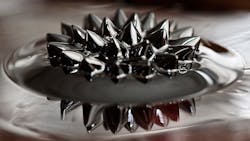Military researchers look for solutions for self-healing legged robots involving liquid metal and heat
WASHINGTON – A legged robot that breaks on the battlefield is a liability. But new research into self-healing joints for legged robots could pave the way to a future of autonomous, self-repairing machines. Defense News reports. Continue reading original article
The Military & Aerospace Electronics take:
16 Jan. 2020 -- Legged robots have value for infantry because they enable machines to traverse inclines and rough terrain that’s ill-suited for wheels. In addition, legs can carry robots up ladders and over walls. Its one reason the U.S. has pursued several iterations of robot dogs for military use.
If a leg breaks in the field, soldiers depending on that robot are left with a handful of unpleasant options.
Yet new research, by the University of Tokyo’s JSK Lab and reported by IEEE Spectrum in December, used special joints, liquid metal, and heat to let a robot break its leg and then heal.
Related: Flexible flat silicone cables for robotics and mobile teleconferencing introduced by Cicoil
John Keller, chief editor
Military & Aerospace Electronics
